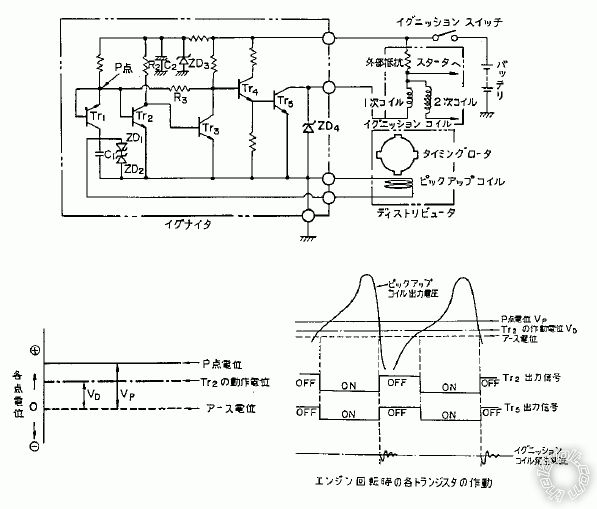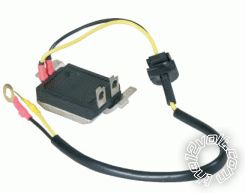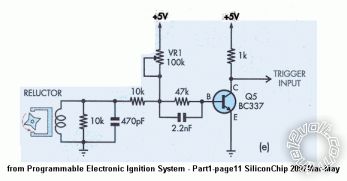motorcycle replacement ignition module
Printed From: the12volt.com
Forum Name: Motorcycle Electronics
Forum Discription: Installing Stereos, Alarms, Remote Starters, Lights, Garage Door Openers and other electronics on motorcycles.
URL: https://www.the12volt.com/installbay/forum_posts.asp?tid=121797
Printed Date: December 12, 2025 at 11:37 AM
Topic: motorcycle replacement ignition module
Posted By: rasa74
Subject: motorcycle replacement ignition module
Date Posted: May 12, 2010 at 3:05 AM
HI everyone.
Getting straight to it, i lost my TCI unit and im toying with a replacement. Its a gsxr 250, 4 cylinder, 2 coils with wasted spark triggered by two reluctor pulsers. I plunbed in a mechanical timing advance so now basically want a schematic to build a simple trigger unit to trigger the coils. I guess i wiil have to use two unit but im fine with that. Its not CDI but TCI, coil gets a 12 v supply and grounds through the trigger. Could anyone help me out with a schematic please.
Thanks
Replies:
Posted By: awdeclipse
Date Posted: May 12, 2010 at 10:43 AM
Feed "Ignition Coil Driver Circuit" into your favorite search engine. Plenty of results will come up. I would think a number of Low Side Driver would be suitable for this task.
You don't have to account for Coil Dwell time with this setup? Is that taken into account by the width of the reluctor teeth/tooth?
Posted By: oldspark
Date Posted: May 12, 2010 at 1:13 PM
LOL! I haven't used dwell since Kettering days! (Though I merely gapped.)
CDI does not use dwell.
And dwell is usually done electronically; eg 6-9mS off times - at least with my aftermarket and kit experience.
Reluctors etc are thus often a position trigger (conventionally the negative-going zero crossing).
Though some systems like the Lucas-RITA use the initial rising slope to provide speed advance.
And then there is my favourite circuit below from a 1970's engine (Isuzu G200W twincam).
The trigger is merely TR1 & TR2.
TR1 is a constant-current source for pickup coil, and TR2 does the switching.
The other transistors amplify to dive the ignition coil.
I like it because it is simple and no voltage trimming is required.
And it imitates Kettering's dwell.
Alas no circuit values, but shouldn't be too tricky for electronic gurus. (These days you would use a MOSFET to drive the Ignition Coil instead of TR's 4 & 5, and maybe TR3.)

Posted By: rasa74
Date Posted: May 15, 2010 at 2:40 AM
Hi again.
As usual, i didnt make myself clear, sorry.
Its not a CDI ignition but a TCI ignition. The coils gets 12v power and gets earthed through the module to collapse the field and causing it to spark. Basically just like the old kettering/ points and condenser setup, only instead of the points, it has a inductive coil which is triggered by a magnetic reluctor. I believe the coils are of about 300 ohms. I want to use the same pulser coils to trigger a transistorized setup to collapse the field in the coil.
Most of the schematics online are for a trigger with points or just a setup to run a coil on the bench with a timer. I need a 12vdc setup, im assuming with a 2N3055 , triggered by my existing pulser to in turn trigger my 12v coil. Again, i stress, its TCI not CDI. The coil gets a 12v fedd and grounds through this unit.
Thanks for all the replies and looking forward to more.
Posted By: oldspark
Date Posted: May 15, 2010 at 6:37 AM
It doesn't matter - so does the above.... (it's the full ignition circuit).
I've been using the later ignitors from Isuzu RB Geminis/i-Mark (FWDs) which have been bluddy fantastic (current limited; starts from cold with original ~1.2Ohm "blue IgCoil" at 5.2V; runs with ~0.3 Ohm Bosch MEC717 & 723 coils).
They use a 160-Ohm reluctor but should work with 300 Ohms.
Aftermarket versions include the TIM081 module...

... a mere >$200 new, but apparently about $0 from self-serve wreckers, else under $40 for the whole distributor. They are also used in Nissans and others typically from the 1980s (mid'80s to mid-90s?), and other ignitors are similar.
Otherwise an alternate trigger circuit commonly used in Silicon Chip (magazine) projects...

These days MOSFETS are usually used instead of transistors.
And usually the 2N3055 wasn't used, but others (which I'd have to look up).
Posted By: rasa74
Date Posted: May 17, 2010 at 8:36 AM
Thanks Oldspark
I have seen this trigger circuit before but as it is, do i just connect the trigger input connection straight to the coil negative? and what exactly does the pot control in the circuit?
And seeing that you know what your talking about, another query please. I have a Honda cBR 250, last weekend, the fan wire came off and i never realised that it was HOT coz the guage is kinda low, how could i hook up a red led somewhere more visible to come on at a set temp. I guess i will have to plumb in a separate switch or can i somehow get it to work with the existing thermo switch for the guage,to come on at a specific resistance?
Posted By: oldspark
Date Posted: May 17, 2010 at 10:00 AM
That is merely a trigger circuit. A BC337 only handles max 800mA - a coil may need 8A but usually less.
Like TR2 or TR3 in the old Isuzu sensor circuit, it needs buffering to switch a coil. Probably MOSFETs are the cheapest/simplest solution.
The trim-pot is to cater for different sensors (coils) and is usually adjusted to that Q5 is just switched on when there is no signal from the pickup coil. (See - I told you the Isuzu version was good - +12V supply; no adjustments; and by design triggers close to zero volts.)
For temp sensing - either get a temp switch for redundancy etc.
If 50, 60, (not 70) 80, 90, 100, 110 degrees C that is required, NO (Normally Open) switches aka "Klixons" are available that typically have spade terminals and can switch 5A. Price here is ~AUD$5 each.
But there are alternatives...
To use your gauge sensor, you won't have that independence (ie, if the sensor - or gauge - fails...) and you'll need some sort of voltage-adjustable switch - aka a comparator circuit.
|


